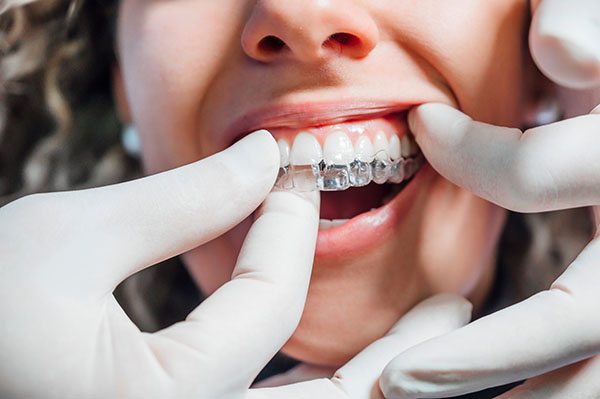 Invisalign® is one of several options you might be considering for straightening teeth. It is a way to correct the alignment by regularly changing the trays as the teeth move into the proper positions. While it may not be right for everybody, many people with less complex orthodontic cases have success using Invisalign. With Invisalign, your teeth-straightening trays can move teeth closer together or farther apart as needed.
Invisalign® is one of several options you might be considering for straightening teeth. It is a way to correct the alignment by regularly changing the trays as the teeth move into the proper positions. While it may not be right for everybody, many people with less complex orthodontic cases have success using Invisalign. With Invisalign, your teeth-straightening trays can move teeth closer together or farther apart as needed.
When Invisalign works better
Teeth can be out of alignment when too close together, overcrowded, or spaced too far apart. Invisalign works more effectively if the gap is no bigger than six millimeters. It can also help with mildly rotated teeth. Invisalign will also work well for mild overbite and underbite issues. More severe issues may need other orthodontic work. Other dental issues that respond well to Invisalign are:
Maturity can be a factor. Younger patients are more likely to misplace Invisalign trays. The Invisalign process works better when the patient wears the trays for the recommended number of hours per day. Patients who cannot stick with a good routine will struggle. Older teens and adults who follow the dentist’s instructions will see more success.
Who may want to reconsider
Patients who have severe overcrowding and need one or more teeth extracted may not be ideal candidates for Invisalign. In serious cases, teeth can be well in front or back of the rest. Traditional braces are better for moving these teeth into place. Some people who have had an extraction due to overcrowding may not be able to use Invisalign after.
Children and younger teens may not see success with Invisalign. Young people’s jaws are still growing. As the jawbone continues to grow, teeth may rotate on their own, or gaps may open up between teeth. The work that the teeth-straightening trays did may not last. Traditional braces can be more effective because the dentist can adjust them as the patient’s jaw grows.
Some dental work does not work well with Invisalign. Invisalign moves teeth individually. Bridgework bonds to multiple teeth and might not move properly. Invisalign can damage other dental work like veneers and crowns.
Less complex for more success
Mild to moderate alignment issues respond well to Invisalign. Patients who do not have any severe oral conditions and follow a good oral hygiene regimen have the most success. Wearers with less complex cases are less likely to have complications during the process. Less complex orthodontic cases also take less time to correct and are less likely to regress after. Patients need to consult with the dentist to determine if they are good candidates for Invisalign.
The only way for you to know for sure if Invisalign will be effective is to see a dentist. The dentist will perform an exam and identify all orthodontic issues. You can work with your dentists to map out a plan of care that addresses both appearance and oral health. For many, Invisalign is a useful tool in this plan.
Request an appointment or call Visalia Care Dental at 559-975-1213 for an appointment in our Visalia office.
Related Posts
You may know that Invisalign® is different than traditional braces, but you may not know all the reasons why. Both Invisalign and traditional braces straighten your teeth and correct other issues, but in very different ways. For many, Invisalign aligners are a great choice to straighten the teeth without visible brackets and wires. There are…
In recent years, Invisalign® has become increasingly popular to straighten misaligned teeth. There are many benefits of this type of orthodontic treatment over traditional braces. Patients can remove the aligners to brush and floss the teeth, making oral hygiene measures much easier. Treatment time is often shorter, and the clear trays are not as noticeable…
Invisalign® and braces are very different tools that can give patients an even smile with straightened teeth. Because patients must wear teeth alignment devices for a while, you might wonder if you will need repairs to your device. Patients often wonder if one type of device needs more repairing than another. For most patients, one…
